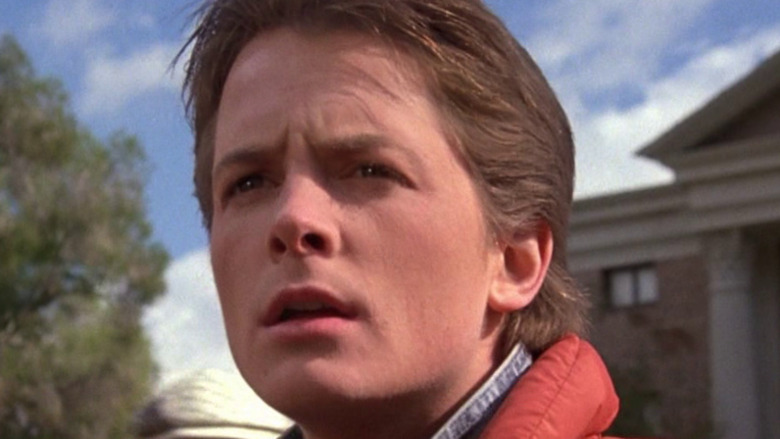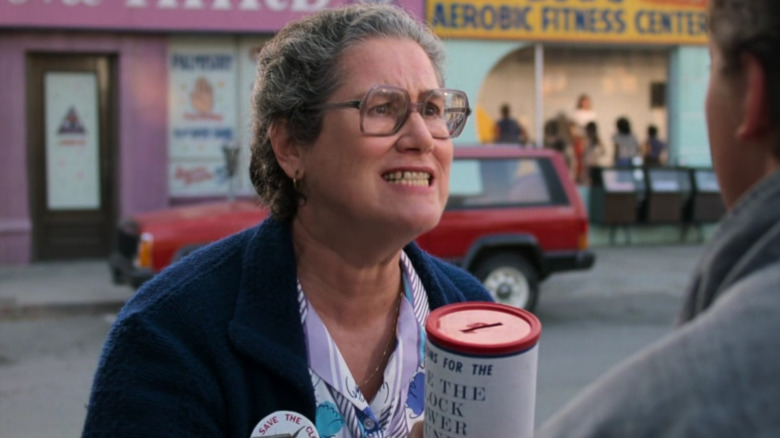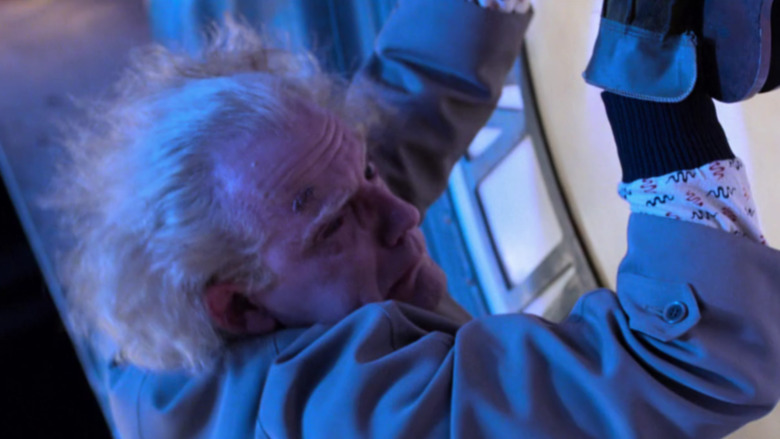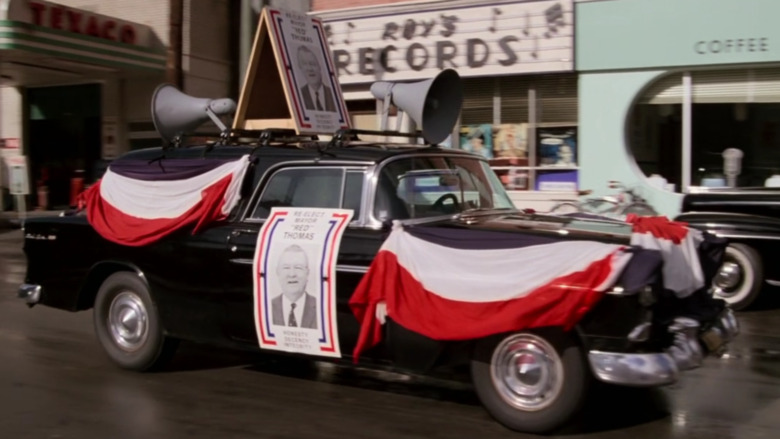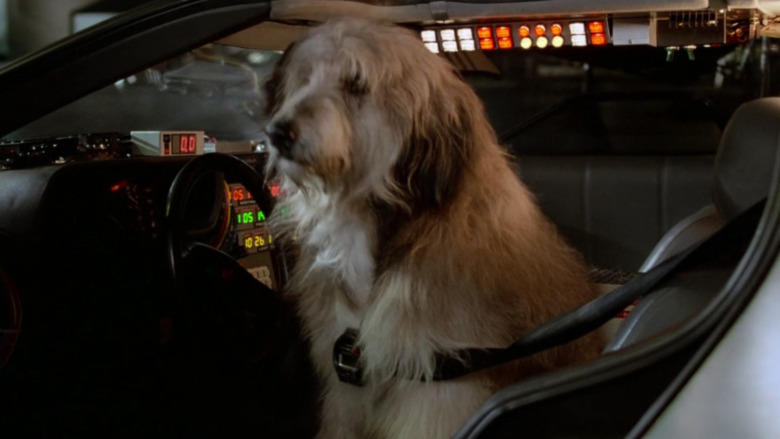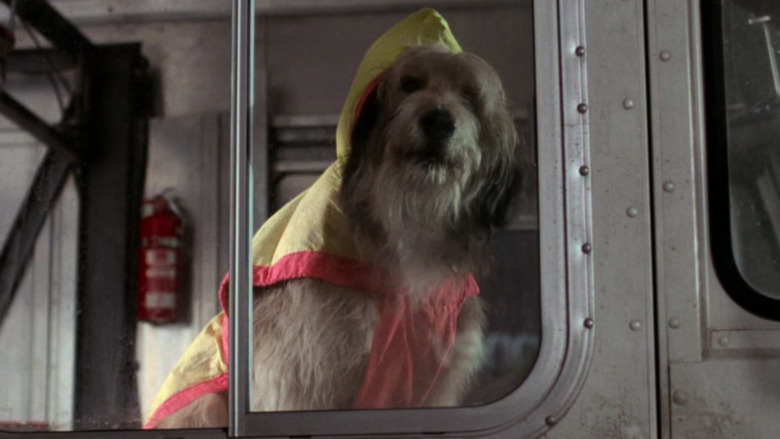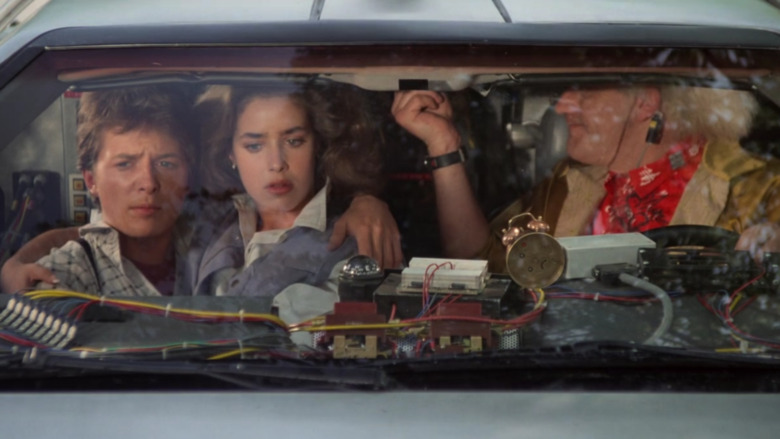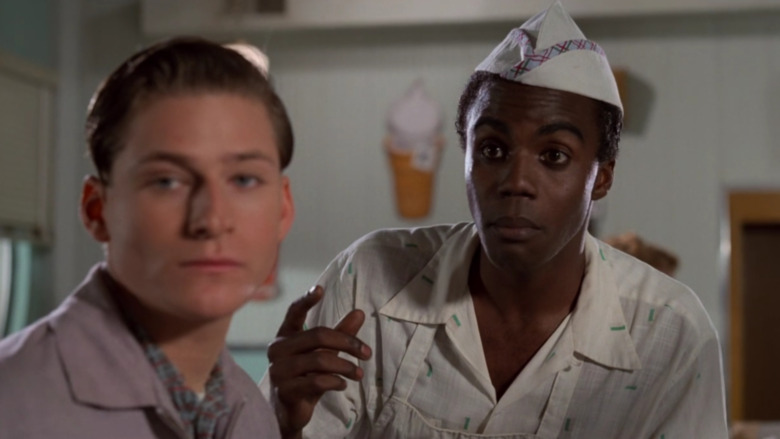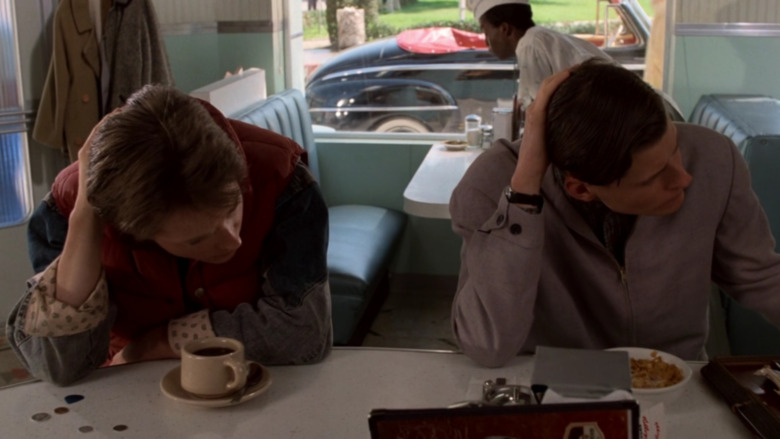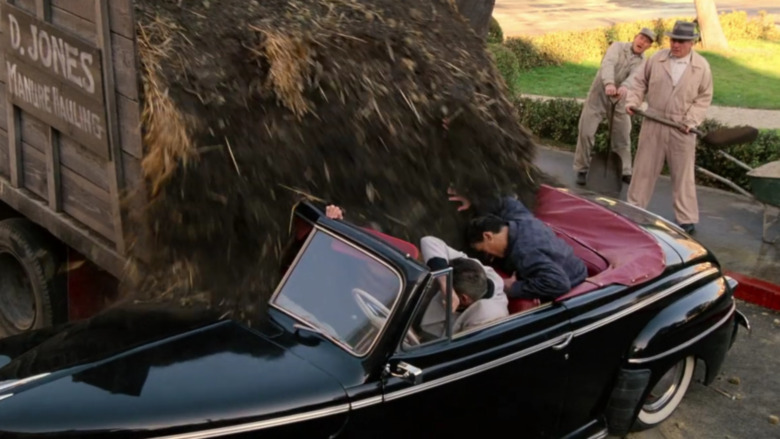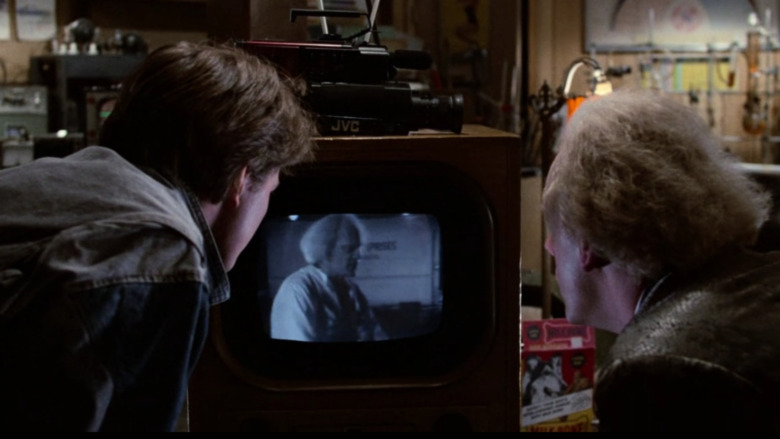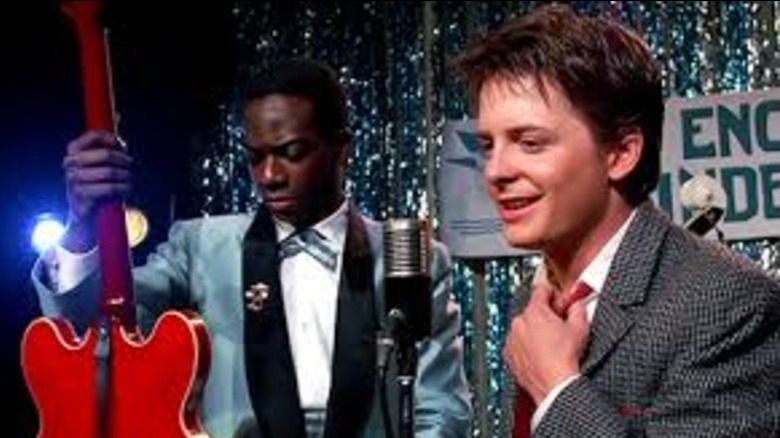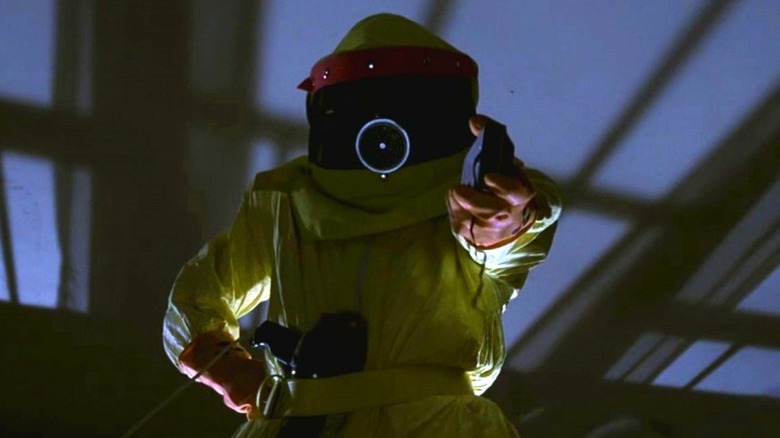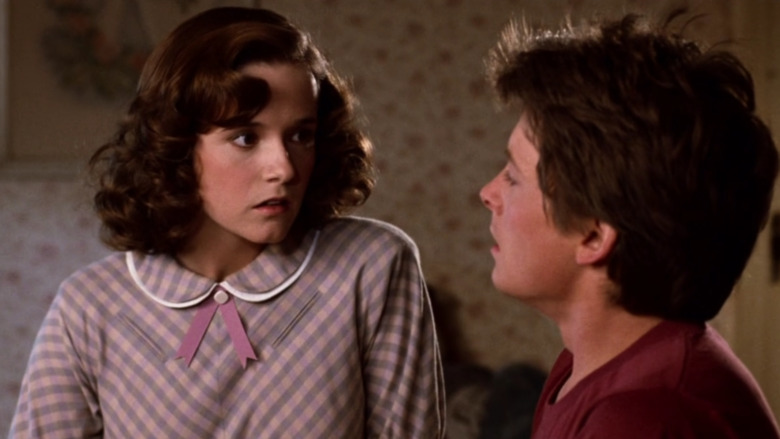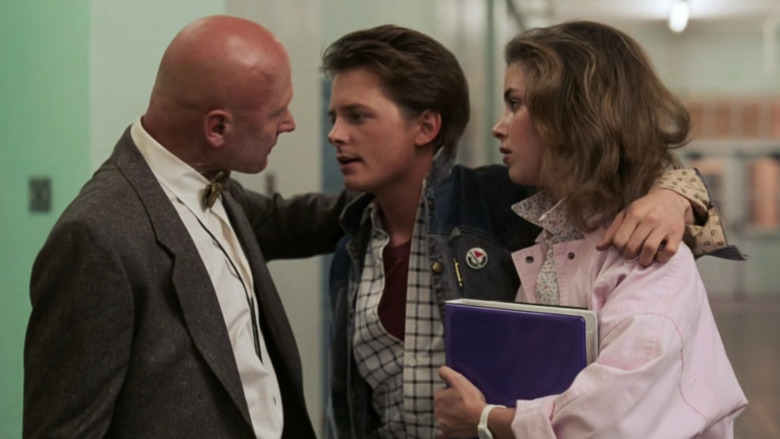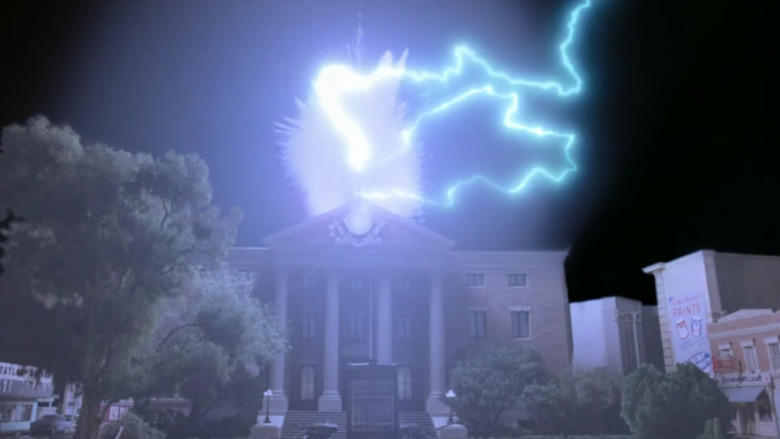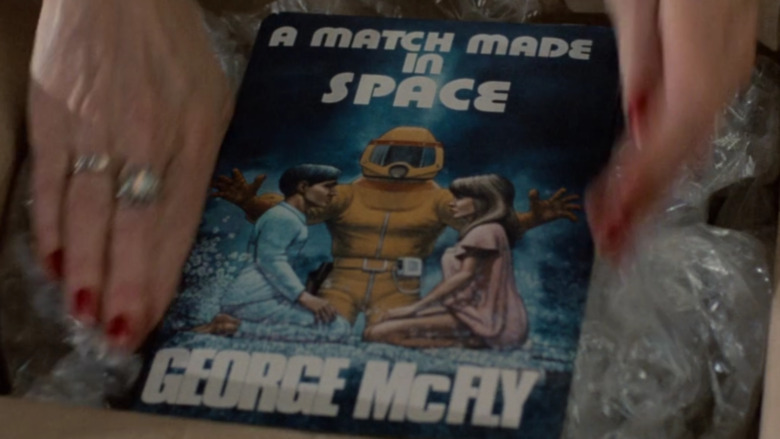Things You Only Notice In Back To The Future After Watching It More Than Once
We love revisiting our favorite movies. And in the case of "Back to the Future," a rewatch is even thematically appropriate: We can relive a little bit of our past, and even if we wouldn't change anything about the movie, we get to change our experience by noticing things we missed the first time around.
And there's a lot to notice, because while "Back to the Future" is non-stop fun, it's also a thoughtful film full of rewarding little details. Even the sharpest observers might miss something the first time around, and you're probably not pausing the movie to think about the effect of every single paradox Marty introduces into his timeline. Luckily, there's never a bad time to rewatch "Back to the Future" — just ask "Back to the Future Part II," which sneaks around in the events of the first film — and we've got a viewer's guide for some of the repeat-viewing bonuses that really stand out.
The movie takes time out for foreshadowing
Some of the foreshadowing in "Back to the Future" isn't exactly subtle, but other bits are easier to miss. For example, when Marty (Michael J. Fox) worries about sending out his audition tape, he speculates about the record company telling him he has "no future." Sure enough, he almost doesn't.
If you look at some of these early moments long enough, you find out how layered they really are, especially once you know the course the movie is going to take. In the scene where Strickland (James Tolkan) scolds Marty, it's easy to notice "history's gonna change," but it's also important that Strickland (correctly, if cruelly) tags George McFly's lack of drive — or lack of backbone, really — as the reason George "never amounted to anything." And that turns out to be exactly the part of history Marty changes. Similarly, when you think about it, the Save the Clock Tower campaigner really picked the wrong person to approach about historical preservation.
Safety Last!
If you're a fan of silent comedies, few images are as iconic as poor beleaguered Harold Lloyd dangling from the hand of an enormous clock in "Safety Last." If you know the film — or even the shot — there's no way you can see Doc Brown hanging off the clock tower without gasping in recognition. It's a great homage, especially when you remember that Doc is played by yet another (unrelated) Lloyd — Christopher, this time. Lloyds of the world, you should probably all stay away from clock towers, just in case.
"Back to the Future" isn't content with just one "Safety Last" homage, though. It sneaks in a second — one that doubles as foreshadowing for Doc's later bit of aerial comedy. In the film's opening, when the camera pans over Doc's clock collection, we see that one of the clocks has a tiny Lloyd figurine hooked onto one of the hands. We buy Doc Brown as a "Safety Last" fan: He's a man of good taste.
A classic slogan
No one tunes in to a time travel caper for the small town mayoral race. But you still shouldn't miss this cynical joke about the cyclical nature of politics.
In Marty's original 1985 timeline, mayor Goldie Wilson is running for reelection, and "progress is his middle name." Political and civic progress, that is ... because we're sure not talking about creative progress. Back in 1955, Mayor Red Thomas is busy using the exact same slogan. And, for that matter, the exact same pitch: "more jobs, better education, bigger civic improvements, and lower taxes." We bet his predecessor followed exactly the same script.
If you're paying enough attention, you might notice that the two campaigns match each other word for word, but subsequent viewings give you more time to appreciate the layered ironies here. Our personal favorite: Both of these mayoral candidates are incumbents. Their campaigns are promoting change ... as the reason to keep on re-electing the same guy.
Einstein vs. Laika
The space race between the United States and the Soviet Union officially kicked off in 1955, the same year George McFly (Crispin Glover) and Lorraine Baines (Lea Thompson) kissed at the Enchantment Under the Sea Dance. (Two events of equal historical importance, right?) "Back to the Future" doesn't grapple much with Cold War paranoia, but you can bet that it's in the background.
The Soviet Union might have been the first nation to get a satellite into orbit, and they may have had the first surviving animal passenger — the dog Laika — but hey, if you believe "Back to the Future," America has Doc Brown's faithful dog Einstein, the first surviving animal to travel through time. Consider winning the fictional time race a consolation prize for taking a knock in the real-life space race. And don't you imagine Laika and Einstein would have a lot to talk about? They both deserve to be celebrities.
Einstein deserves his name
When Doc Brown tests his time-traveling DeLorean by sending the adorable Einstein on a solo trip through time, we fully get Marty's alarm. Couldn't he have tested this out on something less ... cute?
But we have to admit that there's a pretty good reason to use Einstein for the initial test run, and it's not just to avoid risking human life. The truth is, Einstein is a genius. If you don't believe us, check out his attempt to warn Doc that the Libyan terrorists are speeding into the parking lot. He's not just smart; he's loyal, too.
But the most convincing example of Einstein's intelligence comes when he hops out of the frost-covered DeLorean ... because the next time we see Einstein, he's managed to put on a jacket to warm himself back up. He's not only smart, he's sensible. And since that's a trait mad scientists like Doc sometimes lack, Einstein makes a good scientific partner.
Sequel bait
You can't deny that "Back to the Future" uses its last few minutes to set up "Part II." But there's one bit of sequel bait that only gets a double-take once you've seen the first two movies.
Right before the Libyan nationalists crash the party, Doc Brown mentions his high-minded time travel goals: "I've always dreamed of seeing the future, looking beyond my years, seeing the progress of mankind." Very noble and inspiring. Then he adds something that most of us would probably find even more inspiring: "I'll also be able to see who wins the next 25 World Series." Good joke ... until you take it in the context of all the havoc Biff will later wreak with the sports almanac.
Plus, it makes Doc's outrage about Marty's identical money-making scheme in "Part II" kind of hypocritical. But then again, thanks to time travel, the Doc who gleefully hoped to learn the World Series winners technically isn't the same Doc who reproached Marty for besmirching the nobility of time travel. Maybe having 30 years to speculate on probable consequences understandably changed his mind.
The good old days?
Lately, we've had plenty of nostalgia for the '80s — just as the '70s and '80s had plenty of similar nostalgia for the '50s. "Back to the Future" was part of that wistful cultural wave, and the set design proves it: Once upon a time, Hill Valley definitely had more civic pride and less vandalism.
But the movie's view of this nostalgia is nuanced, and it doesn't hesitate to skewer exactly this kind of longing for the past. In "Back to the Future," we see that the '50s were far from innocent. Both Goldie Wilson (Donald Fullilove) and the band playing the school dance get racist slurs thrown at them; they're supposed to "stay in their place." While the '50s didn't have an adult movie theater in the town square, it still had rapists and peeping toms and — of course — casual sex. Honestly, compared with all that, Marty's dream of a night away at the lake with his steady girlfriend seems positively wholesome.
Even the most basic bits of nostalgia get subtly taken to task here. Idealized family dinners? As soon as they get the chance, Lorraine's family is thrilled to watch TV while they're eating ... just like the McFlys in the '80s.
Like father, like son
At first glance, Marty McFly and his dad don't seem to have much in common. After encountering them both in 1955, even Doc Brown can't quite believe that they're related: "Maybe you're adopted," he tells Marty.
But of course, the whole plot of the film then turns on Marty being George and Lorraine's biological son. It's concrete proof of the McFly bloodline ... but we don't really need it. Because against all odds, the film makes it clear that George and Marty actually have a lot in common, right down to their body language. And even more meaningfully, they share some identical anxieties about rejection: Neither one of them can initially work up the courage to submit their creative work to someone who might turn it down.
All the father-son parallels get a heartwarming payoff in the end. Marty helps George find his courage — and seeing his father stand up for himself plays an implicit role in helping Marty get up on stage and perform in front of a whole crowd, even losing himself in the music. And when he gets gawked at by a bunch of '50s teens who can't believe what they're hearing? It turns out that he takes rejection pretty gracefully after all.
Where'd you learn to drive?
Biff Tannen (Thomas F. Wilson) is a bully and a would-be rapist, which probably puts "bad driver" pretty far down on his list of sins. But it's just as consistent a character trait as the rest of his awful behavior.
At the film's start in 1985, Biff wrecking the car he's borrowed from George McFly is an obvious example of his rudeness and entitlement: He'll crash your car and make you pay for it. But the best part is Biff's insistence that George never told him the car "has a blind spot." Every car has a blind spot, Biff! Our theory: Biff somehow got George to do all his driver's ed assignments and tests for him, too. This guy just shouldn't have a license, and that's why he's spent 30 years totaling everything he gets his hands on.
Because when Biff tries to ram Marty back in the '50s, that attempted bit of vehicular manslaughter and its spectacular, manure-flooded reversal isn't just hilarious. It's proof that Biff's bad driving is a lifelong habit.
Just like in the movies
Life imitates art — and when an unrecognizable vessel crashes into your barn and a mysterious figure in a full-body suit emerges, you might well think aliens. Especially if it's 1955 and you're a kid with a collection of comic books chock-full of UFOs and creatures from outer space. Books, movies, TV, comics — these things are just part of how we relate to the world around us.
"Back to the Future" knows that. One of Biff's pals has the gimmick of always wearing a pair of 3-D glasses around, a nod to the '50s craze for 3-D ... which would return in Marty's '80s, making it another one of the film's examples of how the more things change, the more they stay the same.
But the best bit of meta-fictional art and life overlap in "Back to the Future" comes when Marty hooks up his camcorder to Doc's 1955 TV to show him the footage taken right before Marty traveled in time. As Marty and Doc rewind and fast-forward to get to the parts they need in the tape, they're duplicating the time-travel process, moving backwards and forwards in Marty's (future) historical record.
'Your kids are gonna love it'
Kids and their parents have always clashed over music: The artform might evolve and change, but once our tastes are fixed, they often stay the same. Sooner or later, we're all bound to get confused by the latest hits. Needless to say, Marty nails the phenomenon when he plays '80s guitar for a baffled '50s dance crowd: "I guess you guys aren't ready for that yet," he says. "But your kids are gonna love it."
"Back to the Future" has an even better example of how parents suffer when their kids crank up the volume on music that they just can't understand. When Marty dons his hazmat suit to scare the 1955 version of his dad into believing he needs to ask out Lorraine, he amps up the weirdness by blasting George with Van Halen. George writhes in agony ... as he's literally tortured by his son's taste in music.
George McFly, alien conspiracy theorist
We get to see George McFly in 1955 and 1985, but let's face it: After Marty meddles with the original timeline, our biggest questions about George mean we need to see him in 1966 and 1977. Because if one of the most memorable experiences of your life is "Darth Vader from the planet Vulcan" waking you up to threateningly micromanage your love life ... what happens when "Star Trek" and "Star Wars" come out?
There are a lot of possibilities here, admittedly. We know that "A Match Made in Space," published in 1985, is George's first novel, but he could have written a ton of short stories over 30 years. Did he wind up snagging both those names before Gene Roddenberry and George Lucas could get around to using them? Or does he think that Gene Roddenberry and George Lucas also got alien visits that they drew on for inspiration? It surely has to be enough to make him a true believer in extraterrestrials.
If Marty had just made up some names, all of this could have been averted. But since he made the exact same geeky references we would have, we have to wonder what his dad eventually thought about it.
Calvin's sexier
We all get a kick out of 1955's Lorraine thinking that Marty's name is Calvin Klein because "it's written all over [his] underwear." Follow that up with her wide-eyed, husky announcement that she's "never seen purple underwear before," and we're laughing and cringing at the same time. Poor Marty.
Marty — not Calvin. We can remember that, even if Lorraine has more trouble with it. Even though he tries to take the focus off his underwear by telling his now 17-year-old mom that people call him Marty, Lorraine only gets it right about half the time.
Clearly, Lorraine just thinks Calvin is the sexier name. If you want proof, notice how much better she is about calling Marty "Marty" after their kiss in the car has fallen flat (much to Marty's relief). Once she's started falling head over heels for George, she suddenly forgets all about "Calvin" and starts seeing Marty as Marty. What a nice boy. She just might name her son after him.
Tardy Marty
All through "Back to the Future," Marty has a serious problem: He's late to almost everything. Of course, it doesn't help that all the clocks in Doc's workshop are set to the wrong time — but even if that helps explain all the school latenesses that Marty's racked up, it doesn't excuse him lingering at the dance when he knows he has to make it to the clock tower on time. We all like "Johnny B. Goode," Marty, but come on: priorities. You don't want to get stuck in 1955!
But the ongoing background detail of Marty's lateness gets a satisfying — and briefly bittersweet — twist: It makes it a huge deal that when he finally thinks to arrive early, it's to save Doc's life. Marty giving himself 10 additional minutes to get to the mall parking lot to keep Doc from getting shot is a terrific character beat. He may be late for everything else — even his own future — but when someone else's life is at stake, he steps up and overturns the habit of a lifetime.
Precision lightning
When it comes to time, we probably have no business criticizing Doc Brown. He invented the flux capacitor, and we're just still frustrated about Daylight Savings Time. But we've at least mastered the fact that there are 60 seconds in a minute.
Marty knows the exact time and date that the Hill Valley clock tower will be struck by lightning ... sort of. He knows the day, hour, and minute, but a lightning strike is a pretty instantaneous phenomenon. He has to hit Doc Brown's wire at the exact right second, and he has no idea which second that will be. Of course, as Doc Brown himself points out, there are a lot of fiddly little details that have to be worked out exactly right for Marty to be able to make it back to 1985. But this one seems even harder to get right than most. It's probably a good thing that when Doc comes back from the future, he's got a more reliable fuel source.
Book-lover bonus
George McFly's new career as a novelist is the perfect cherry on top of his happier, better-adjusted life in the revised 1985. And if you take a good look at the cover of "A Match Made in Space," you might notice that it bears a resemblance to some of real-life science fiction author Robert A. Heinlein's cover art. Connections between George and Heinlein are likely anyway: He's one of the sci-fi authors the younger George would have absolutely grown up reading, for one thing.
Although George doesn't know it, his own life winds up being like something out of a Heinlein story ... and not just because he's living in a science fiction movie. Heinlein's short story "—All You Zombies—" deals with how time travel paradoxes lead to a man becoming several of his own ancestors, for example. In a decidedly less family-friendly version of "Back to the Future," we could see that happening to Marty, too. Most uncomfortably, Heinlein's novel "Time Enough for Love" tackles multiple kinds of incest in a science fiction setting, including a romance between a woman and her son. Awkward doesn't begin to cover it.
